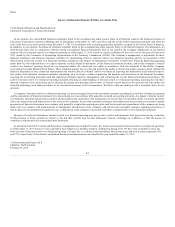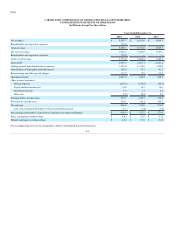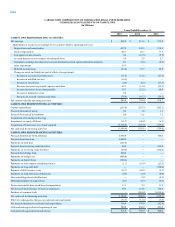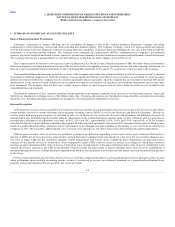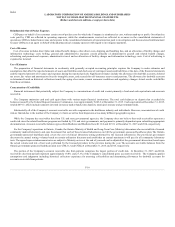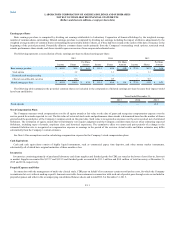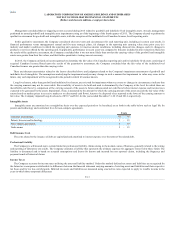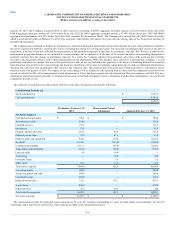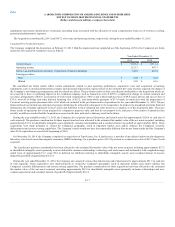LabCorp 2015 Annual Report Download - page 89
Download and view the complete annual report
Please find page 89 of the 2015 LabCorp annual report below. You can navigate through the pages in the report by either clicking on the pages listed below, or by using the keyword search tool below to find specific information within the annual report.
Index
Examples of output measures in early development services, include among others, the number of slides read, or specimens prepared for preclinical laboratory
services, or number of dosings or number of volunteers enrolled for clinical pharmacology. Examples of output measures in the clinical trials services,
include among others, number of investigators enrolled, number of sites initiated, number of patients enrolled and number of monitoring visits completed.
Revenue is determined by dividing the actual units of work completed by the total units of work required under the contract and multiplying that percentage
by the total contract value. The total contract value, or total contractual payments, represents the aggregate contracted price for each of the agreed upon
services to be provided. CDD does not have any contractual arrangements spanning multiple accounting periods where revenue is recognized on a
proportional-performance basis under which the Company has earned more than an immaterial amount of performance-based revenue (i.e., potential
additional revenue tied to specific deliverables or performance). Changes in the scope of work are common, especially under long-term contracts, and
generally result in a change in contract value. Once the client has agreed to the changes in scope and renegotiated pricing terms, the contract value is
amended with revenue recognized as described above. Estimates of costs to complete are made to provide, where appropriate, for losses expected on
contracts. Costs are not deferred in anticipation of contracts being awarded, but instead are expensed as incurred.
Billing schedules and payment terms are generally negotiated on a contract-by-contract basis. In some cases, CDD bills the client for the total contract
value in progress-based installments as certain non-contingent billing milestones are reached over the contract duration, such as, but not limited to, contract
signing, initial dosing, investigator site initiation, patient enrollment or database lock. The term “billing milestone” relates only to a billing trigger in a
contract whereby amounts become billable and payable in accordance with a negotiated predetermined billing schedule throughout the term of a project.
These billing milestones are generally not performance-based (i.e., there is no potential additional consideration tied to specific deliverables or performance).
In other cases, billing and payment terms are tied to the passage of time (e.g., monthly billings). In either case, the total contract value and aggregate amounts
billed to the client would be the same at the end of the project. While CDD attempts to negotiate terms that provide for billing and payment of services prior
or within close proximity to the provision of services, this is not always possible, and there are fluctuations in the levels of unbilled services and unearned
revenue from period to period. While a project is ongoing, cash payments are not necessarily representative of aggregate revenue earned at any particular
point in time, as revenues are recognized when services are provided, while amounts billed and paid are in accordance with the negotiated billing and
payment terms.
In some cases, payments received are in excess of revenue recognized. For example, a contract invoicing schedule may provide for an upfront payment of
10% of the full contract value upon contract signing, but at the time of signing performance of services has not yet begun. Payments received in advance of
services being provided are deferred as unearned revenue on the balance sheet. As the contracted services are subsequently performed and the associated
revenue is recognized, the unearned revenue balance is reduced by the amount of revenue recognized during the period.
In other cases, services may be provided and revenue recognized before the client is invoiced. In these cases, revenue recognized will exceed amounts
billed, and the difference, representing an unbilled receivable, is recorded for the amount that is currently unbillable to the customer pursuant to contractual
terms. Once the client is invoiced, the unbilled services are reduced for the amount billed, and a corresponding account receivable is recorded. All unbilled
services are billable to customers within one year from the respective balance sheet date.
Most contracts are terminable with or without cause by the client, either immediately or upon notice. These contracts often require payment to CDD of
expenses to wind down the study or project, fees earned to date and, in some cases, a termination fee or a payment to CDD of some portion of the fees or
profits that could have been earned by CDD under the contract if it had not been terminated early. Termination fees are included in net revenues when
services are performed and realization is assured. In connection with the management of multi-site clinical trials, CDD pays on behalf of its customers fees to
investigators, volunteers and certain out-of-pocket costs, for which it is reimbursed at cost, without mark-up or profit. Investigator fees are not reflected in net
revenues or expenses where CDD acts in the capacity of an agent on behalf of the pharmaceutical company sponsor, passing through these costs without risk
or reward to CDD. All other out-of-pocket costs are included in total revenues and expenses.
The Company's net revenues are comprised of the following:
Years Ended December 31,
2015
2014
2013
LCD - net revenue $ 6,199.3
$ 5,838.0
$ 5,669.4
CDD - net revenue 2,306.4
173.6
138.9
CDD - reimbursable out-of-pocket expenses 174.4
—
—
Total revenues $ 8,680.1
$ 6,011.6
$ 5,808.3
F-9




